HIGHLIGHTS
PROGRAM UPDATES
Women of Carbon Documentary Features Lumber Industry’s Sustainability Initiatives The AWC Releases New Regional EPDs to Meet Market Demand for Sustainability Data Think Wood Showcases Wood’s Benefits in High-Growth K-12 Education Sector WoodWorks’ Strong Foundation in Light-Frame Continues to Deliver Projects SLB’s TIMBER IN THE CITY Competition Inspires Students to Embrace Wood DesignINSIGHTS ON THE COMPETITION
Concrete Masonry Checkoff Unveils National Marketing CampaignProgram Updates
Women of Carbon Documentary Features Lumber Industry’s Sustainability Initiatives

Several of the women featured in the “Women of Carbon” documentary: Anyeley Hallová (Adre), Rachael Jamison (AWC), Stacey Smedley (Building Transparency), Cristy Fiander (Yakama Nation Forest Products), Kate Simonen (Carbon Leadership Forum), Rena Simon (ZGF Architecture) & Mija Hubler (Prometheus Materials/CU Boulder).
In August, the premiere of a new documentary, “Women of Carbon,” was held in Portland and featured women who are leading the effort to decarbonize the built environment. The film, whose sponsors include the AWC and the SLB, introduced 19 women, including the AWC’s own Vice President of Sustainability and Markets, Rachael Jamison, who discussed the central role of mass timber and wood products as a “right now” solution to decarbonize the built environment.
The film features women working in the industries of wood, concrete, and steel who are focused on increasing sustainability and innovating for the future by addressing the carbon emissions associated with the built environment and construction sector. From wood sourcing to laboratory research to finished buildings, the film explored how women are affecting each part of a building’s life cycle.
Jamison was one of the wood product experts discussing how mass timber is a ready solution to help decrease the carbon impact of the built environment. She was joined on screen by architect Susan Jones of atelierjones, Erica Spiritos of Timberlab, Rena Simon of ZGF, and Anyeley Hallová of Adre to give voice to the greater wood products industry, including forestry, policy, design, and construction. The film highlighted specific mass timber projects like T3 in Atlanta, Heartwood in Seattle, and the mass timber modular homes used to rebuild Greenville, California. This allowed viewers to see the current, tangible success of mass timber projects across the country. The SLB and AWC’s involvement in the film helped to highlight for viewers how wood products are already addressing both the embodied carbon footprint of the built environment and solving social needs related to climate change like fire-resistant and seismic-tested building materials.
The premiere drew representatives from the three major building materials, wood, concrete, and steel, as well as sector nonprofits, regional construction companies, and architects. The film is not yet available for digital viewing, but the trailer can be watched online at https://womenofcarbon.solareye.biz/. Upcoming screenings are scheduled for October in Seattle and at the Newport Beach Film Fest, with additional dates to come.
The AWC Releases New Regional EPDs to Meet Market Demand for Sustainability Data
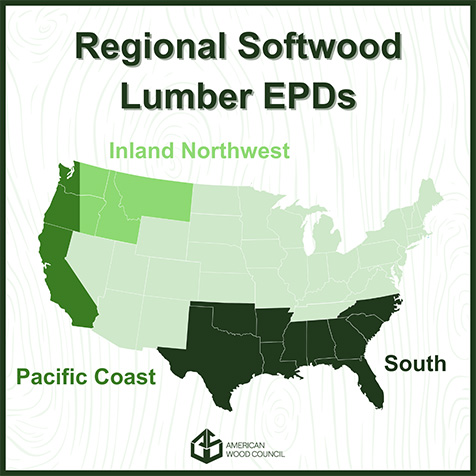
The AWC has released three of four regional Environmental Product Declarations (EPDs) for U.S. softwood lumber. This marks the first time the U.S. lumber industry has developed and published regional EPDs; previous industry EPDs have been North American in scope. The newly released EPDs cover the Pacific Coast, the Inland Northwest, and the U.S. South regions. More mill data is needed to complete a fourth EPD for the North/Northeast region, and it is expected to be completed early next year.
The updated EPDs represent the AWC and the wood products industry’s response to continued requests for more granular data. The design industry uses EPDs to support carbon emission reduction by comparing the impacts of different materials and products in order to select the most sustainable option. As consumers, regulators, and the AEC community voiced their desire for specific, localized EPDs, the AWC expanded its mill data collection platform to include more mills to ensure the industry was meeting market demands and continuing its commitment to radical transparency.
“These regional EPDs are a game-changer for our industry and demonstrate the sector’s responsiveness to market demands,” says Rachael Jamison, Vice President of Sustainability and Markets at the AWC. “They directly address the growing consumer and regulatory interest in data surrounding the environmental impacts of U.S. wood products and demonstrate the U.S. industry’s commitment to radical transparency. The new EPDs are something the entire U.S. wood products industry should be proud of.”
The new EPDs are available on the AWC’s website. The Life Cycle Survey is open to all SLB investors for FY2023 data collection. Contact Anna Ostrander at aostrander@awc.org for help getting started.
Think Wood Showcases Wood’s Benefits in High-Growth K-12 Education Sector
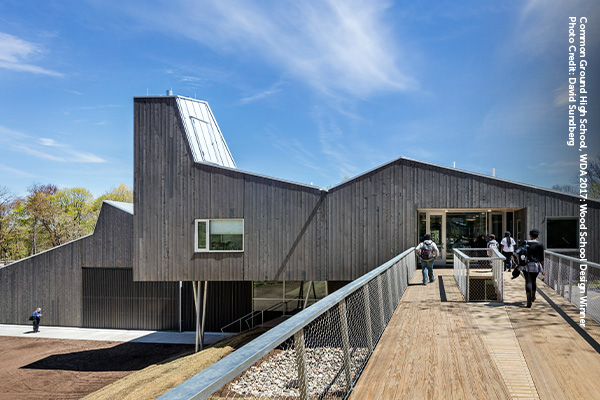
The education sector represents a significant opportunity for the lumber industry, with a potential market opportunity of 1.7 BBF, according to an outlook prepared for the SLB by Forest Economic Advisors. Architects, engineers, and general contractors are paying attention to this opportunity as well, with the American Institute of Architects’ mid-year construction forecast finding that the institutional market—and education, in particular—will help to offset the overall weak commercial market, with projected growth of 11% this year and 4% next year.
Think Wood has been highlighting innovative education facilities built with light-frame and mass timber systems throughout the year, and a recent article collects several notable projects and resources focusing on the K-12 segment.
“Creating healthy, sustainable, 21st century schools starts with using the right materials, and as school districts set ambitious sustainability goals, building with wood presents new opportunities,” the article says. “In addition to carbon reductions, designing and building modern schools with wood prioritizes occupant well-being and streamlines costs to create warm, welcoming spaces centered on learning.”
WoodWorks’ Strong Foundation in Light-Frame Continues to Deliver Projects
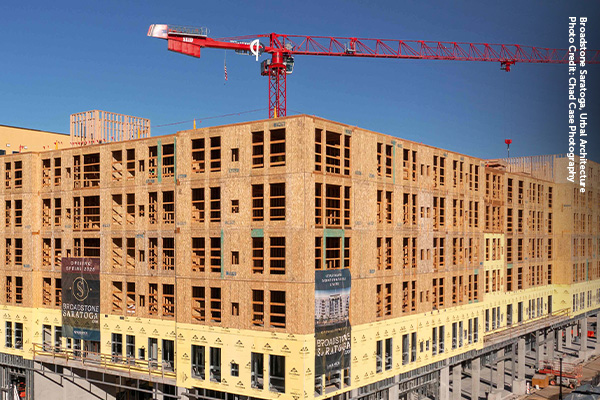
With its expertise in all aspects of light-frame wood buildings, WoodWorks is well established as the go-to organization for architects, structural engineers, and contractors who run into issues on projects. Among the recent examples:
After attending the team’s first WoodWorks webinar, an architectural firm working on its first Type III-A wood project—a 590,000-square-foot apartment building with five stories of light-frame wood over a three-level podium—reached out for assistance. This team is known for designing high-rise concrete multifamily developments, but not midrise and not with wood. WoodWorks provided a Lunch & Learn on Type III exterior walls and followed up with a project-specific meeting to discuss topics such as fire walls, fire retardant-treated wood balconies, acoustics, concealed spaces, and parapets. The firm was excited by the extensive availability of resources and opportunity for direct support.
WoodWorks recently supported a structural engineering team working on an unusual light-frame mixed-use project. A city’s transit operations and maintenance facility proposed apartments over its two-story operations building, and the team was having issues determining the appropriate stud wall sizing and shear wall design. WoodWorks provided a solution and the engineer replied, “This was insanely helpful. […] The ability to look to WoodWorks for technical assistance resolves hurdles that may have caused the design team to look to other materials for solutions.”
Meanwhile, a contractor reached out to WoodWorks when bids were coming in higher than expected for a 400,000-square-foot 4-over-1 project in Arizona—largely because of the concrete podium. The contractor had a fairly significant misperception related to code provisions for these structures, which WoodWorks clarified. WoodWorks also shared options for reducing costs by eliminating the podium and introducing firewalls. When a contractor has done only smaller-scale wood buildings, they often don’t understand the code implications of larger and taller light-frame wood projects. This contractor found WoodWorks’ expertise and resources helpful in navigating the differences. Check out more innovative light-frame projects highlighted on the WoodWorks Innovation Network.
SLB’s TIMBER IN THE CITY Competition Inspires Students to Embrace Wood Design

The SLB-sponsored “TIMBER IN THE CITY 5: Urban Habitats Competition,” hosted by the Association of Collegiate Schools of Architecture (ACSA), set a transformative agenda for future urban development. The competition challenged architecture students across the country to think innovatively about the integration of wood in the urban built environment with a theme focused on increasing urban density through innovative wood-based vertical extensions, or overbuilds, assembled on top of existing buildings or infrastructure.
The competition’s focus resonated with the current cohort of students, culminating in 259 students from 46 schools of architecture developing 159 innovative proposals to meet urban housing needs while addressing affordability and sustainability. The 5 winners and 2 honorable mentions included MAXX TIMBER: Between Home and Forest (pictured above), a submission from Columbia University architecture students that addresses housing affordability and sustainability by adding mass timber vertical extensions to a New York City Housing Authority campus in downtown Brooklyn.
The SLB aims to further promote student innovation by collaborating with key academic organizations and providing a compelling alternative to established programs like the Concrete Masonry and Hardscape Association’s Concrete Masonry Competition and the American Institute of Steel Construction’s Steel Competition.
The SLB and ACSA also recently announced winners for the SLB’s 2024 Timber Education Prize. The collegiate faculty competition recognizes innovative coursework and curricula that create a stimulating environment for learning about wood as a building material.
The winning entries included the University of Virginia’s “Design from Tree to Timber: Building Non-Planar Futures,” which will utilize robotic sawmill technology to provide students hands-on experience with advanced wood fabrication, cultivating future architects who are proficient in innovative wood construction methods. By accepting the funds, faculty winners agree to make the courses available to students within two years and for the developed course content to be made available for other schools to adopt and further implement. The competition, now in its third year, is solely funded by the SLB and has provided awards to a total of 15 innovative courses. This SLB initiative is a catalyst to cultivate an AEC workforce proficient in wood solutions.
Spotlight
With Six Buildings Complete, Hines’ T3 Mass Timber Concept Still Growing
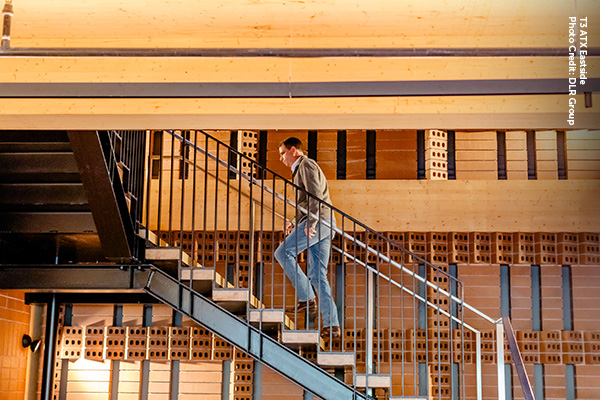
Ten years after architecture firm DLR Group began working on the first T3 mass timber office building for developer Hines, six T3 buildings have been completed and five more are in design or construction across North America. The most recent, T3 ATX Eastside in Austin, Texas, was featured in a recent Think Wood video that highlights how developers are using mass timber to differentiate their office projects for occupants, corporate tenants, and investors.
In a recent article on DLR’s website, Design Leader Stephen Cavanaugh highlights his lessons learned in financial viability, building code influence, environmental impact, and in other areas. “If there’s one major takeaway from our experiences over the past decade, it’s that the use of mass timber in the built environment is only just getting started,” Cavanaugh says. “As building codes continue to catch up to market demand, the possibilities for timber are endless.”
T3 ATX Eastside is the first T3 to offer Class A timber office space as well as residential units. T3—short for Timber, Transit, Technology—began as a concept from Hines submitted as part of the Tall Wood Building Prize competition in 2015. Through initiatives including project highlights at Think Wood, project conversion and support at WoodWorks, and the AWC’s work to expand mass timber building codes to more states, the SLB and its funded programs are working to foster innovative, yet repeatable, mass timber buildings that diversify and expand markets for lumber.
“In 2018, with Amazon as an anchor tenant, Hines sold T3 North Loop to LaSalle for the highest per square foot cost in Minneapolis history. This price was also well above the average price per square foot in the traditionally more covetable Central Business District.”
– Stephen Cavanaugh, Design Leader, DLR Group
T3 ATX Eastside is the first T3 to offer Class A timber office space as well as residential units. T3—short for Timber, Transit, Technology—began as a concept from Hines submitted as part of the Tall Wood Building Prize competition in 2015. Through initiatives including project highlights at Think Wood, project conversion and support at WoodWorks, and the AWC’s work to expand mass timber building codes to more states, the SLB and its funded programs are working to foster innovative, yet repeatable, mass timber buildings that diversify and expand markets for lumber.
Insights on the Competition
Concrete Masonry Checkoff Unveils National Marketing Campaign
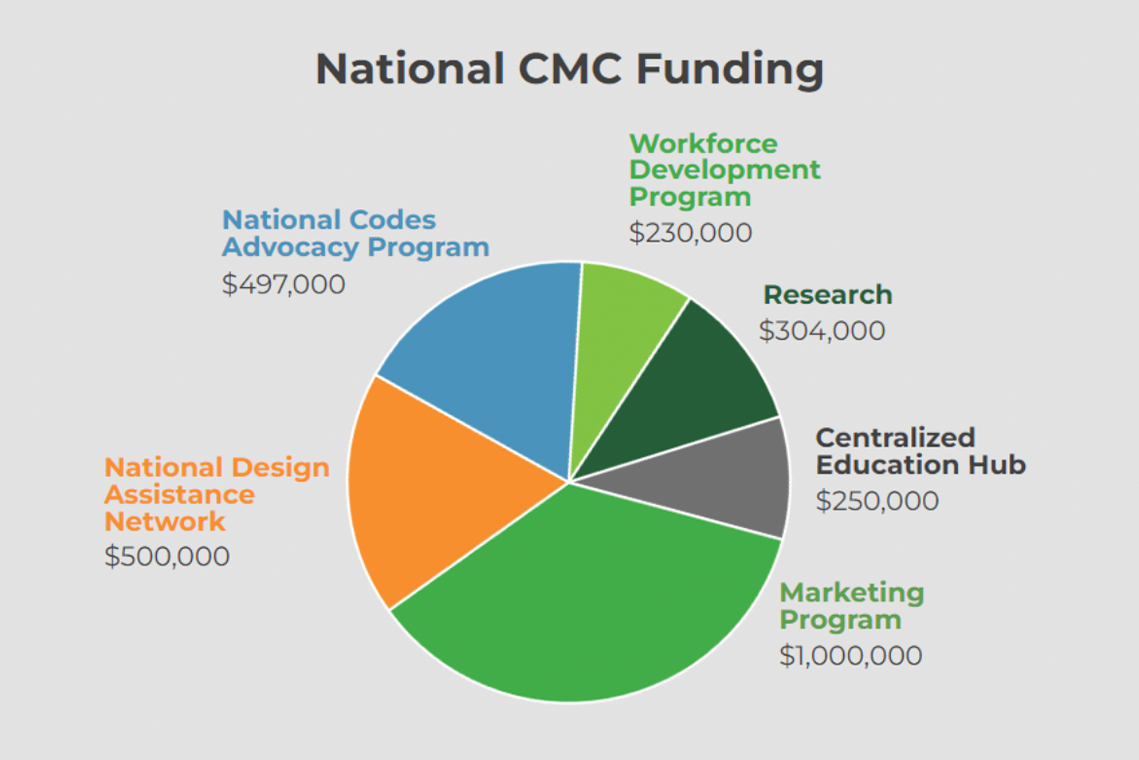
The Concrete Masonry Checkoff (CMC), the first checkoff program established for a competing building material, has been up and running for about a year and recently launched a national marketing campaign: The Beauty of Block. Like Think Wood, The Beauty of Block targets architecture, engineering, and construction audiences, touting concrete block’s strength, sustainability, safety, and stylishness.
“It’s time to defy perceptions of style,” says a new video on the CMC campaign website. “With unlimited imagination and design flexibility, and strength that can withstand Mother Nature while standing for generations. It’s time to insist on sustainability that saves on every level. It’s time to take a new look at concrete block.”
The CMC’s published program allocations indicate a 2024 budget of $1 million for the marketing program alongside $500,000 for a national design assistance network, $497,000 for a national codes advocacy program, $230,000 for a workforce development program, and $250,000 for a centralized education hub. The total national and regional program budget is $4.3 million.
Industry Resources
FEA's Housing Dashboard
This housing dashboard is provided compliments of Forest Economic Advisors (FEA).
View the August Housing Dashboard
View the September Housing Dashboard
Virginia Tech's Monthly Housing Report
This monthly housing commentary report is a free service of Virginia Tech and is intended to help one gauge future business activity in the U.S. housing market.
July 2024 Reports (released in September 2024)
Part A: July Housing Commentary
Part B: July Economic Conditions


